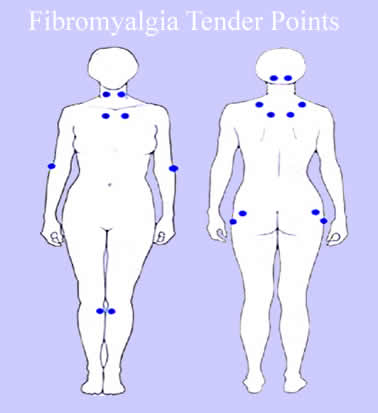Can Fibromyalgia Cause Chest Pain?
Fibromyalgia is typically characterized by widespread pain with multiple tender points. It can cause an array of other symptoms, too – such as fatigue, depression, and sleep disturbance. Sometimes the pain occurs in the neck and chest areas. Can fibromyalgia also cause chest pain, a symptom that is often associated with problems affecting the heart?
 The first thing you may think about chest pain is heart problem, especially such as heart attack which is a scary thing. But in fact, there are a number of health conditions behind the problem that range from mild to serious. The problem can be caused by something else in the body such as problems in the esophagus, lungs, ribs, nerves, and muscles. Even sometimes psychological conditions (anxiety and panic attacks for examples) can also factor into chest pain.
The first thing you may think about chest pain is heart problem, especially such as heart attack which is a scary thing. But in fact, there are a number of health conditions behind the problem that range from mild to serious. The problem can be caused by something else in the body such as problems in the esophagus, lungs, ribs, nerves, and muscles. Even sometimes psychological conditions (anxiety and panic attacks for examples) can also factor into chest pain.
But whatever is it, it is not something to ignore – particularly true if it persists or worsens. If you have unexplained chest pain, it’s much better to have a medical professional evaluate you!
In general, here are some common causes of the problem:
Heart diseases
Chest pain can be a signal of the following heart problems:
- Angina, a blockage in your heart blood vessel. This blockage can reduce both blood flow and oxygen to your heart muscles. As a result, your chest can be painful (typically characterized by a pressure /squeezing sensation in the chest). The pain usually worsens with emotional stress and physical activity (exercise), but improves with rest.
- Heart attack, an emergency condition in which the blood supply to the heart is suddenly discontinued (blocked). If it’s not immediately treated, it can cause serious /permanent damage to the heart muscle cells or even a death. The symptoms can be similar to angina, but typically more severe and will not relieve with rest.
- Other heart problems such as mitral valve prolapse (a failure of a heart valve to close properly), myocarditis (inflammation of heart muscle), hypertrophic cardiomyopathy (abnormal growth of heart muscle that causes abnormal blood flow out of the heart), and pericarditis (infection /inflammation of the heart sac).
Lung diseases
Your chest area is not only about the heart. The lungs – for example, are also located in the chest, inside your rib cage. Problem in the lungs can sometimes be painful, too. There are a variety of types of lung disease that can lead to chest pain. These include pneumonia, pleuritis, pulmonary embolism, pulmonary hypertension, pneumothorax, and asthma.
What else?
- Problems affecting nerves, muscles, and bones in the chest area – such as rib problems and muscle strain.
- GERD, gastroesophageal reflux disease, is a condition in which stomach acid leaks up into the throat. It can causes heartburn (a burning sensation in the throat or chest) that can be similar to heart pain, because the esophagus and heart are located close to each other.
- Other gastrointestinal problems such as esophageal problems, peptic ulcers, pancreatitis, hiatal hernia, and gallbladder disorder.
It seems that it’s not always easy to determine the underlying cause of chest pain, because there are numerous different conditions that can cause the problem. How about fibromyalgia?
Though fibromyalgia is quite common, it’s not always easy to diagnose. Sometimes diagnosing the disease can be tough. In fact, the pain can be highly personal. When one patient says that the pain hurts all over the body, this is not necessarily the same as another.
Therefore, the diagnosis of the disease usually requires a comprehensive physical examination that checks for particular tender points on the body.
Tender points of fibromyalgia are localized, pain points that easily get hurt under pressure (when pressed with a finger for example). Typically, they are not deep areas of pain but more sensitive than other nearby areas. The size is usually not large, only about the size of a penny.
The answer of why these tender points occur is not fully known. Even though the disease is categorized into rheumatic diseases (a group of disorders characterized by inflammation) and the affected areas look inflamed, there is actually no inflammation. Many times, inflammatory markers are normal (not high) in patients with fibromyalgia. Also, the disease doesn’t cause damage to the affected joint see more in here!
What is known, fibromyalgia tender points are predictable. They are not random, but more likely to occur in several locations on the body. In other words, patients usually have similar symptoms with pressure points.
Theoretically, fibromyalgia has 18 tender points (9 pairs). To diagnose the disease, the patient should have at least 11 of these tender points, according to the American College of Rheumatology. These points are scattered throughout the body such as over the knees, buttocks, hips, elbows, chest, back, and neck (see image below)!

How about chest pain?
The bad news, fibromyalgia can also coexist with costochondritis, an inflammation of the cartilage that connects the ribs to the sternum. And the challenges mount if you have these two conditions, since having either one is painful enough!
Costochondritis is quite common in people with fibromyalgia. Even one study suggests that about 60-70 percent of them experience signs and symptoms that mimic those of costochondritis. Though the link is not fully understood yet, it’s not uncommon to find these two conditions together.
The good news, costochondritis is usually mild (not serious). Many times, it’s only a minor injury though sometimes it can relapse. Also, it will not cause permanent damage to the affected area. How long it lasts varies, typically it takes a few days or weeks to heal – but in a few cases it can also last for months.
Even though costochondritis is often considered mild, it can sometimes be very bothersome in the chest. This is especially true if it coexists with another health condition such as fibromyalgia.
Characteristics and symptoms of costochondritis are as follows:



